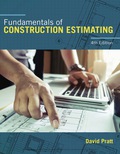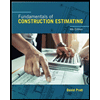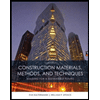
a)
The identification of wall forms in the given figure.
b)
The identification of slab edge forms in the given figure.
c)
The identification of column forms in the given figure.
d)
The identification of beam forms in the given figure.
e)
The identification of slab soffit forms in the given figure.
f)
The precise measurement in a formwork takeoff.
g)
The reason for measurement of pilaster forms separately from wall forms if the concrete in walls and pilasters is measured together.
h)
The opening of size in an area of formwork would be deducted from the gross area of the forms.
i)
The three examples of formwork items measured in linear feet.
j)
The measurement of the circular columns formwork.
Trending nowThis is a popular solution!

Chapter 5 Solutions
Fundamentals of Construction Estimating
- (2) Volume of aeration tank, V-12000m (3) Influent BOD, Y.- 300 mg/1 (4) Effluent BOD, Y, 25 mg/1 (5) Mixed liquor suspended solids (MLSS), X,-2500mg/1 (6) Effluent suspended solids, X-30mg/1 (7) Waste sludge suspended solids, XR-9700mg/1 (8) Quantity of waste sludge, Q., 220m³/d 100 Based on the information above data, determine: (a) Aeration period (hrs.) (b) Food to microorganism ratio (F/M) (kg BOD per day/kg MLSS) (c) Percentage efficiency of BOD removal (d) Sludge age (days)arrow_forwardWrite handwritten solution, answer a,b and c Refer to the soil profile shown in the Figure a. Calculate the variation of o, u, and o' with depth. b. If the water table rises to the top of the ground surface, what is the change in the effective stress at the bottom of the clay layer? c. How many meters must the groundwater table rise to decrease the effective stress by 15 kN/m? at the bottom of the clay layer?arrow_forwardWater is discharged into the atmosphere through a bent nozzle of an angle (a) as shown in the figure. The cross-sectional area at the nozzle inlet and outlet are (Ain) and (Aout), respectively. The discharge through the nozzle is (Q). The gauge pressure at the nozzle inlet is (Pin). The bend lies in a horizontal plane. Vin Ain Aout Atmosphere Vout Problem (9): Given the values of Ain [m²], Aout [m²], Pin [atm], Q [m³/s], and a [degrees], calculate the magnitude of the reaction force component in x-direction (Rx) in [N]. Givens: A in = 0.301 m^2 Aout Pin = 0.177 m^2 1.338 atm Q α = 0.669 m^3/s 37.183 degrees Answers: ( 1 ) 23028.076 N ( 2 ) 29697.962 N ( 3 ) 18633.611 N ( 4 ) 14114.988 Narrow_forward
- Please answer the following question in the picture and show all of your work please.arrow_forwardPlease answer the following questions and make sure you answer each question please.arrow_forwardWater is discharged into the atmosphere through a bent nozzle of an angle (a) as shown in the figure. The cross-sectional area at the nozzle inlet and outlet are (Ain) and (Aout), respectively. The discharge through the nozzle is (Q). The gauge pressure at the nozzle inlet is (Pin). The bend lies in a horizontal plane. Ain Vin Aout X Atmosphere Vout Problem (10): Given the values of Ain [m2], Aout [m²], Pin [atm], Q [m³/s], and a [degrees], calculate the magnitude of the reaction force component in y-direction (Ry) in [N]. Givens: A in 0.169 m^2 A out Pin 0.143 m^2 0.552 atm = Q α 0.367 m^3/s = 31.72 degrees Answers: ( 1 ) 6264.193 N (2) 12041.886 N ( 3 ) 8715.747 N ( 4 ) 7139.937 Narrow_forward
- Problem (12): A pump is being used to lift water from the bottom tank to the top tank in a pipe of diameter (d) at a discharge (Q). The pipe system comprises four Long radius 90° threaded elbows. The pipe entrance is sharp-edged, and the pipe exit is sudden. A Ball valve (1/3 closed) is used to control the discharge in the pipeline. Given the values of Q [Lit/s], and d [cm], calculate the power loss due to components (i.e., minor losses) in the pipe (Wminor-loss) in [W]. Givens: Q = 12.275 lit/s d = 6.266 cm Answers: ( 1 ) 1142.006 W (2) 952.086 W ( 3 ) 1225.555 W ( 4 ) 1331.216 W Loss Coefficients for Pipe Components (h,= K,Y) Component a. Elbows KL elbow Regular 90°, flanged 0.3 Regular 90°, threaded 1.5 Long radius 90°, flanged 0.2 V 90° elbow Long radius 90°, threaded 0.7 Long radius 45°, flanged 0.2 0.4 Regular 45°, threaded . 180° return bends 180° return bend, flanged 0.2 V 45° elbow 180° return bend, threaded 1.5 c. Tees Line flow, flanged 0.2 Line flow, threaded 0.9 180°…arrow_forwardCompute for the stresses (initial, const and final stage) and check for compliance in NSCP provisions. Also compute the following: 1. Compute and check if the section is Uncracked, Transition or Cracked as per NSCP. 2. Compute for its flexural capacity and check if it could carry the given load. BEAM SECTION NOT TO SCALE 1400mm 300 $1098 400 */ 400*300* 300 200 300 100 ORIGINAL SECTION/PRECA CAST-IN-PLACE (CIP) PART PRECAST LOADING AT SERVICE M • 21 KN (DEAD LOAD ONLY) 21KN 4.75m 9.25m CIVEN DATA STRANDS: 12-02 AT 120KN/STRAND (GOMM FROM BOTTOM) 8-2 AT 120HN/STRAND (120mm FROM BOTTOM) fc 42.5 MPa (BEAM) fc 38 MPa (CIP) f'a = 80% or fa fp-1860 MPa ESTRANDS 1976Pa OONG 23.6/m³ LOES 1-8% Loss 18% APPLY 3M LIVE LOAD AT CONST. PHASEarrow_forward4. Determine the stability of the cantilever shown in the figure below (use Coulomb earth theory for the lateral stress due to the backfill material). 1 m 0.5 m Backfill 7 = 18.5 kN/m³ • = 30° 20 6 = 20° 6 m Y₁ = 24 kN/m³ 1.2 m 1 m 4.5 m Base soil Clay: 7 = 19 kN/m³,0 = 30%, 0,, = 20°, s,, = 94 kPa a. With s₁ = c = 94 kPa (disregard values), determine allowable soil bearing capacity of the base soil if the factor of safety is equal to 3. b. Determine the FS against overturning. C. Determine the FS against sliding if the coefficient of friction between footing concrete base and soil is b. d. Determine the FS for bearing capacity.arrow_forward
- Directions: Show your solutions explicitly, i.e., do not just write the final answer. 1. A wall footing is to be constructed on a clay soil 1.4 below the ground. The footing is to support a wall that imposes a load of 130 kN per meter of wall length. Considering general shear failure, determine the following: 130 kN/mm 1.4 m a. Footing width if the factor of safety is 3. b. Ultimate bearing capacity if B = 0.95 m. C. New factor of safety. y = 17.92 kN/m² c = 14.5 kPa $ = 30° 1.5 m and has its hottom 2 m below the ground surface.arrow_forward2. A square footing shown has a dimension of 1.5 m x 1.5 m and has its bottom 2 m below the ground surface. The groundwater table is located at a depth of 3 m below the ground surface. Assume a general shear failure. Determine the following: 2 m y = 16 kN/m³ c = 14.5 kPa → = 28° 3 m 1,5 m ysat 18.5 kN/m³ a. Ultimate bearing capacity of the soil beneath the footing (in kPa). b. Allowable bearing capacity if it has a factor of safety of 3 (in kPa). C. Allowable load that the footing could carry (in kN). d. Allowable net bearing capacity if factor of safety is 3. Allowable net load if factor of safety is 3.arrow_forwardProblem (11): A pipe discharges an unknown fluid into the atmosphere from a tank of depth (h) through a pipe of length (L), and diameter (d). Given the values of L [m], d [cm], and (h) [cm], calculate the discharge rate (Q) [lit/s] that would maintain Laminar flow in the pipe with a Reynolds number of Re-1500. Ignore minor losses. Givens: L = 139.364 m d = 12.614 cm h = 76.609 cm Answers: ( 1 ) 6.911 lit/s (2) 8.179 lit/s ( 3 ) 4.244 lit/s (4) 4.987 lit/s h darrow_forward
 Fundamentals Of Construction EstimatingCivil EngineeringISBN:9781337399395Author:Pratt, David J.Publisher:Cengage,
Fundamentals Of Construction EstimatingCivil EngineeringISBN:9781337399395Author:Pratt, David J.Publisher:Cengage, Construction Materials, Methods and Techniques (M...Civil EngineeringISBN:9781305086272Author:William P. Spence, Eva KultermannPublisher:Cengage Learning
Construction Materials, Methods and Techniques (M...Civil EngineeringISBN:9781305086272Author:William P. Spence, Eva KultermannPublisher:Cengage Learning Architectural Drafting and Design (MindTap Course...Civil EngineeringISBN:9781285165738Author:Alan Jefferis, David A. Madsen, David P. MadsenPublisher:Cengage Learning
Architectural Drafting and Design (MindTap Course...Civil EngineeringISBN:9781285165738Author:Alan Jefferis, David A. Madsen, David P. MadsenPublisher:Cengage Learning


